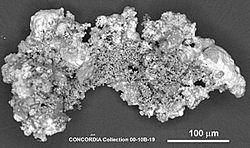微流星体

微流星体是微小的流星体,是在太空中的微小固体,通常质量不到1公克。微陨石是穿越地球的大气层之后依然存在,并到达地球表面的这种物体。
科学的兴趣
|
参见:宇宙尘 |
微流星体非常小,它们通常产生于太阳系诞生之际,是来自于更大块的岩石或金属碎片的碎裂物。微流星体在太空中是很常见的,特别是在地球的附近,普遍存在着微流星体。这些微粒对太空风化过程起到了主要作用。当它们撞击月球或者没有大气层的天体(水星或小行星等)的表面时,会造成这些天体表面的熔解与蒸发,导致表土的变暗和其它的光学变化。为了更加了解微流星体的分布状态,许多太空探测器(包括月球轨道1号、月球3号、火星1号和先锋5号)都曾经携带检测微流星体的仪器设备。
在1957年,汉斯·彼德森首度对落在地球上的微流星体数量进行估计,其数值高达每年14,300,000吨[1]。如果这是真的,那么月球表面将覆盖上很大深度的微流星体,需要很强的侵蚀作用才能将它们移除。在1961年,亚瑟·C·克拉克在掉落的月尘这本小说中,使这种可能性变得众所皆知。这也造成与降落在月球上有利害关系的团体,进行一些新的研究,以便能对这种特征有更好的了解。这包括发射几艘旨在测量微流星体数量的太空船(飞马卫星计划)或直接测量月球表面尘埃的(测量员计划)。这些结果显示微流星尘的数量远远低于早些时候的估计,大约每年只有一万到二万吨,相对而言,月球的表面大部分都是岩石[2]。
由于较大的表面积对质量的比值,微流星体的轨道不像流星体那样的稳定。落到地球的微流星体可以提供太阳星云中有关毫米尺度加热事件的资讯。微陨石(当它们抵达地球表面后的名称)只能在南极等没有地质沉积作用的地区搜集。将冰搜集然后让它溶解和过滤,就能搜集到只能在显微镜下看见的微陨石。
足够小的微流星体够进入地球大气层而不被加热[3]。从1970年代开始,在高空中的飞机就开始搜集这些微流星体[4],从这个时候开始,这些从同温层收集的行星际尘埃(证实了布朗粒子的起源来自地球之外)已经成为可供地球上的实验室研究外星物质构成的重要部分。
对太空船操作的影响
|
参见:太空垃圾 |
微流星体对太空探索有着重大威胁[5]。它们相对于轨道上的太空船有着10Km/s(22,500mph)的相对速度[5],抵抗微流星体的撞击是设计太空船和宇航服所面临的主要挑战(See Thermal Micrometeoroid Garment)。尽管大多数微流星体因为体积的限制,所能造成的损害有限,但数量多时仍会对太空船造成难以估计的损害。高速度的撞击会对太空船的外壳造成类似喷砂的效果,和高度的降低,长期暴露也会危害到太空船各系统的性能。
具有极端高速度(每秒10公里)的小物体撞击是终端弹道学目前正在研究的领域。(将物体加速到如此高的速度是很困难的;目前的技术包括线性马达和成形装药)。这种高速物体的撞击,对在太空中停留很长周期,像是卫星,的风险特别高。对理论上成本相当低的系统,像是太空电梯、轨道飞机、rotovators等系统的工程,都是设计上的重大挑战。
注解
- ^ Pettersson, Hans. "Cosmic Spherules and Meteoritic Dust." Scientific American, Volume 202 Issue 2, February 1960, pp. 123–132.
- ^ Snelling, Andrew and David Rush. "Moon Dust and the Age of the Solar System." (页面存档备份,存于互联网档案馆) Creation Ex-Nihilo Technical Journal, Volume 7, Number 1, 1993, p. 2–42.
- ^ P. Fraundorf (1980) The distribution of temperature maxima for micrometeorites decelerated in the Earth's atmosphere without melting Geophys. Res. Lett. 10:765-768.
- ^ D. E. Brownlee, D. A. Tomandl and E. Olszewski (1977) Interplanetary dust: A new source of extraterrestrial material for laboratory studies, Proc. Lunar Sci. Conf. 8th:149-160.
- ^ 5.0 5.1 Micrometeoroids and Orbital Debris (MMOD) - NASA - White Sands Test Facility, Las Cruces, NM [1] (页面存档备份,存于互联网档案馆)
相关条目
- Extraterrestrial materials
- 行星际尘云
外部链接
- Melted Crumbs from Asteroid Vesta (页面存档备份,存于互联网档案馆) article about micrometeorites collected in Antarctica in Planetary Science Research Discoveries educational journal
| |||||||||||||||||||||||||||||||||||||||||||||||||||||||||||||||||||||||||
Text is available under the CC BY-SA 4.0 license; additional terms may apply.
Images, videos and audio are available under their respective licenses.
